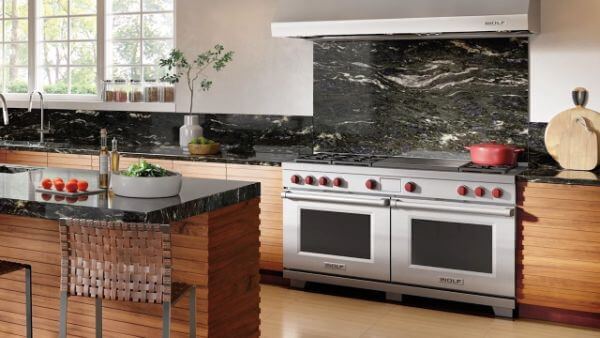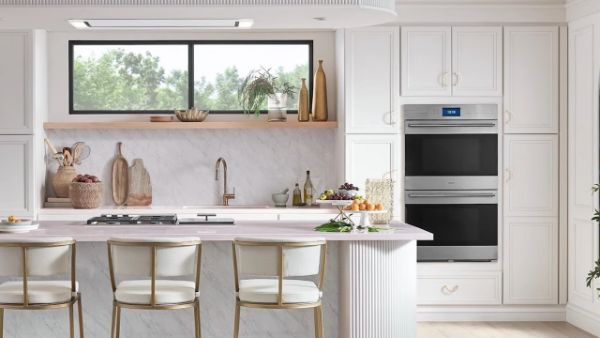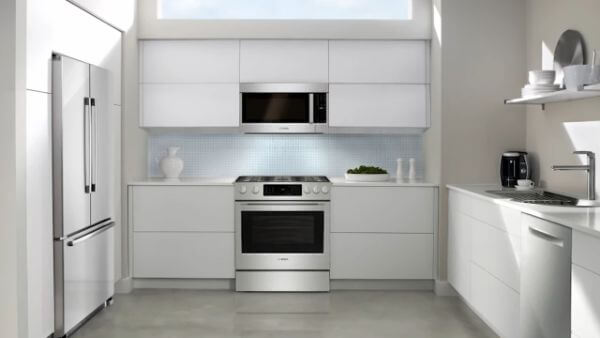No single decision will affect your kitchen design more than choosing a wall oven and range top or cooktop or a range.
But which is right for you?
Centralizing your cooking with a range is more convenient. However, wall ovens can be placed anywhere and open up more design possibilities in your kitchen.
In this article, you’ll learn the pros and cons of both configurations. It’s not just about how much space you have, but also how you cook.
I’ll also include some basic kitchen design tips, definitions of different terms like range top and cooktop.
So in the end, you’ll know what’s right for you and your space.

Table of Contents
Best Kitchen Design
You only have to centralize stovetops, sink and dishwasher. Your wall oven doesn’t have to be centralized because you don’t watch your turkey as often as you stir your soup.
Cooktop vs. Rangetop
People use these terms interchangeably and they shouldn’t. The features and installation are completely different.
The cooktop is the top of a regular stove that is installed on your countertop.
A range top is the top of your pro range and is installed on your cabinet.
A cooktop is less expensive and is available in 12, 15, 24, 30 and 36 inches. 30 and 36 inches being the most popular.
Range tops are more powerful gas types, but you still do have one to two power burners on a cooktop.
Range tops are available in 24, 30, 36, 48 and 60 inch widths. 36 and 48 inches being the most popular.
They also have grill, griddle, French top, sous vide, plus gas and induction combinations.
Now let’s answer your question more directly.

When to Buy a Range?
Maybe your personal preference is to centralize your cooking in one space. Maybe your recipes call for turning the food more frequently, and perhaps you just like that configuration.
In a smaller kitchen, a range will save you space. The most commonly sized range is 30 inches with four burners and an oven.
With a wall oven and cooktop with similar features, it would be that 30 inch cooktop plus an additional 30 inch cabinet as well.
Wall ovens are almost exclusively electric. You may have been told electric is a better way of cooking with its dryer, more consistent temperatures, and it is better for baking.
You can still buy ranges and dual fuel with a gas top and an electric oven, or the induction, which is magnetic, electric heat in an electric oven.
However, a range is also available in all gas. Gas has moisture, so it’s better for roasting. However, the real advantage is broiling. Gas is far better than electric to broil.
Most pro ranges are equipped with an upgraded infrared boiler for more intense directed heat for the best boiling.
Wolf, Miele, Thermador, and Monogram have more combinations on the stovetop and ranges than on the independent range tops only.
When to Buy a Wall Oven?

You need to have, as we said, at least 30 inches extra space for a wall oven and cooktop, versus just 30 inches for the equivalent range.
You could mount a wall oven waist high and never bend for that holiday turkey.
French door side swing ovens allow you to more easily access the heavy holiday roast or turkey rather than lifting that bird over a door.
Monogram, Bluestar, Gaggenau, Thermador and Viking offer a side swing or French door option. Only BlueStar offers a French door and a 36 inch pro range. Double ovens are pretty common for a wall oven in a 30 inch cabinet, but you will need 60 inches for similar ovens in a range.
Steam adds moisture and is the healthiest way to cook. You have far more options in wall ovens than ranges. Every brand offers a decent steam oven to fit over their wall ovens in the standard 30 inch sizes versus just a few in the larger 48 inch pro ranges.
Speed ovens allow you to cook, microwave, and oven to save half the time without the rubbery microwave texture.
You can buy a speed oven in almost every brand to fit over your wall oven. Only Miele offers speed ovens in their larger 48 inch dual fuel pro range.
Warming drawers are great because they can keep food warm for up to 3 hours. If your family eats at different times, a warming drawer is a decent option.
You can place a warming drawer easily under a double oven or single oven with a speed or steam above.
How to Have Both
Anything is possible in a larger space. However possible doesn’t mean it should always be done. Think about what you use regularly and incorporate it in your design. Most commonly, there’s a larger pro range and then separate steam or speed ovens in the island or wall ovens on the opposite wall.
Key Takeaways
In smaller spaces, ranges will be better because they’re more compact. You only need 30 inches for burners versus the 30 inches for a cooktop and another 30 for a cabinet.
However, in mid size or larger kitchens, it’s up to you.
Most of these articles revert to one question, what’s important to you and how you use your burner and ovens?
Ranges have more options in the cooktop and are available in all gas if you like to roast or broil. You don’t bend for a wall oven.
You also have more options in the wall oven with steam, speed or warming drawer.
Remember, ranges are centralized in a kitchen, while wall ovens can be placed anywhere.
With that in mind, you can always incorporate them both in your kitchen.
You can use your traditional double wall oven and range, or split up the wall oven around your island and other parts of your kitchen.
